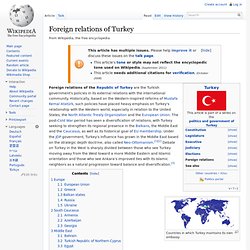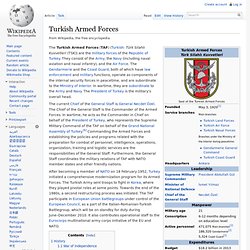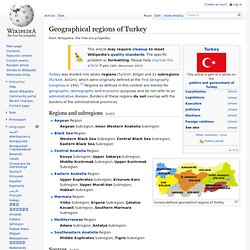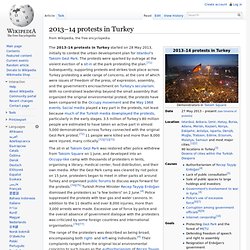

Politics of Turkey. Politics of Turkey. Constitution of Turkey. The constitution was ratified on 7 November 1982.

It replaced the earlier Constitution of 1961. History[edit] Since its founding, the modern Turkish state has been governed under four documents: The current constitution was ratified by popular referendum during the military junta of 1980-1983. Since its ratification in 1982, the current constitution has overseen many important events and changes in the Republic of Turkey, and it has been modified many times to keep up with global and regional geopolitical conjunctures. Overview[edit] Part One: Founding principles[edit] The Constitution asserts that Turkey is a secular (2.1) and democratic (2.1), republic (1.1) that derives its sovereignty (6.1) from the people. Elections in Turkey. Foreign relations of Turkey. Countries in which Turkey maintains its own embassy Europe[edit] European Union[edit] The Turkish application to join the European Economic Community (now the European Union) as an associate member in 1959 soon resulted in associate membership in 1963, with full membership being acknowledged as the final goal.

However, problems in foreign policy such as the Cyprus conflict and the internal political turbulence from the 1970s until the early 1980s forced Turkey to delay applying for full membership of the European Community until 1987. The application was rejected, although the E.C. did say that Turkish membership could occur at some point in the future. An EU-Turkey Customs Union came into effect on 1 January 1996, allowing goods to travel between Turkey and the EU member states without customs restrictions, although it crucially stopped short of lifting restrictions in areas such as agriculture.
Greece[edit] Balkan states[edit] Russia[edit] Ukraine[edit] South Caucasus[edit] Foreign relations of Turkey. Accession of Turkey to the European Union. Turkey's application to accede to the European Economic Community, a predecessor of the European Union (EU), was made on 14 April 1987.

Turkey has been an associate member since 1963.[2] After the ten founding members, Turkey was one of the first countries to become a member of the Council of Europe in 1949, and was also a founding member of the Organisation for Economic Co-operation and Development (OECD) in 1961[3] and the Organization for Security and Co-operation in Europe (OSCE) in 1973. The country has also been an associate member of the Western European Union since 1992, and is a part of the "Western Europe" branch of the Western European and Others Group (WEOG) at the United Nations. Turkey signed a Customs Union agreement with the EU in 1995 and was officially recognised as a candidate for full membership on 12 December 1999, at the Helsinki summit of the European Council.
Turkish Armed Forces. The current Chief of the General Staff is General Necdet Özel.

The Chief of the General Staff is the Commander of the Armed Forces. In wartime, he acts as the Commander in Chief on behalf of the President of Turkey, who represents the Supreme Military Command of the TAF on behalf of the Grand National Assembly of Turkey.[6] Commanding the Armed Forces and establishing the policies and programs related with the preparation for combat of personnel, intelligence, operations, organization, training and logistic services are the responsibilities of the General Staff. Furthermore, the General Staff coordinates the military relations of TAF with NATO member states and other friendly nations. After becoming a member of NATO on 18 February 1952, Turkey initiated a comprehensive modernization program for its Armed Forces.
The Turkish Army sent troops to fight in Korea, where they played pivotal roles at some points. Armed forces of Turkey. Geographical regions of Turkey. Turkey was divided into seven regions (Turkish: bölge) and 21 subregions (Turkish: bölüm), which were originally defined at the First Geography Congress in 1941.[1] Regions as defined in this context are merely for geographic, demographic and economic purposes and do not refer to an administrative division.

Borders of these regions do not overlap with the borders of the administrative provinces. Regions and subregions[edit] Census-defined georaphical regions of Turkey Aegean Region Aegean Subregion, Inner Western Anatolia Subregion Black Sea Region Western Black Sea Subregion, Central Black Sea Subregion, Eastern Black Sea Subregion Central Anatolia Region Konya Subregion, Upper Sakarya Subregion, Middle Kızılırmak Subregion, Upper Kızılırmak Subregion Eastern Anatolia Region Upper Euphrates Subregion, Erzurum-Kars Subregion, Upper Murat-Van Subregion, Hakkari Subregion Marmara Region Yıldız Subregion, Ergene Subregion, Çatalca-Kocaeli Subregion, Southern Marmara Subregion Mediterranean Region.
Provinces of Turkey. Turkey is divided into 81 provinces (Turkish: il/vilayet).

Each province is divided into a number of different districts (Turkish: ilçe). The provincial governorate is set in the central district (Turkish: merkez ilçe). The central district usually bears the name of the province (e.g., the city of Van is the central district of Van Province). There are only 3 exceptions[1] to this naming scheme: Antakya of Hatay provinceİzmit of Kocaeli provinceAdapazarı of Sakarya province.
List of districts of Turkey. List of Turkic dynasties and countries. 2013 protests in Turkey. The 2013–14 protests in Turkey started on 28 May 2013, initially to contest the urban development plan for Istanbul's Taksim Gezi Park.

The protests were sparked by outrage at the violent eviction of a sit-in at the park protesting the plan.[71] Subsequently, supporting protests and strikes took place across Turkey protesting a wide range of concerns, at the core of which were issues of freedom of the press, of expression, assembly, and the government's encroachment on Turkey's secularism. With no centralised leadership beyond the small assembly that organized the original environmental protest, the protests have been compared to the Occupy movement and the May 1968 events. The sit-in at Taksim Gezi Park was restored after police withdrew from Taksim Square on 1 June, and developed into an Occupy-like camp with thousands of protesters in tents, organising a library, medical center, food distribution, and their own media.